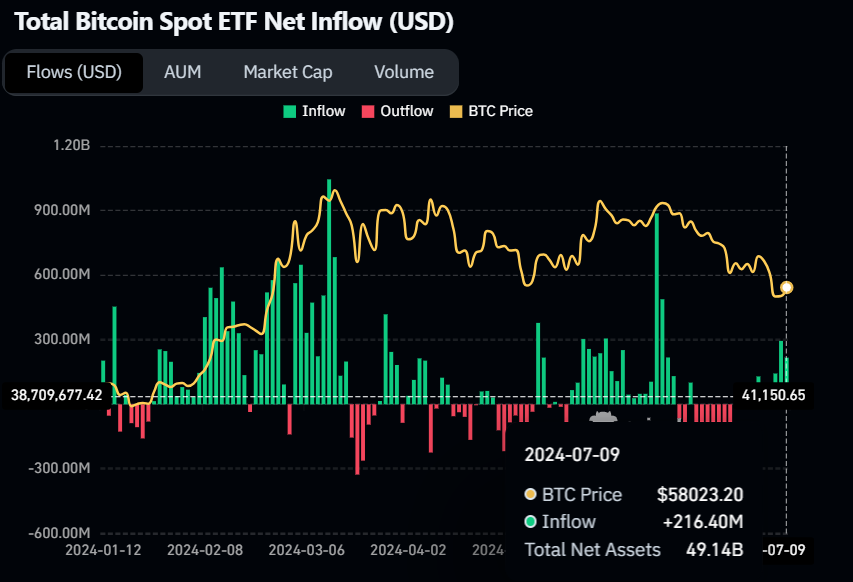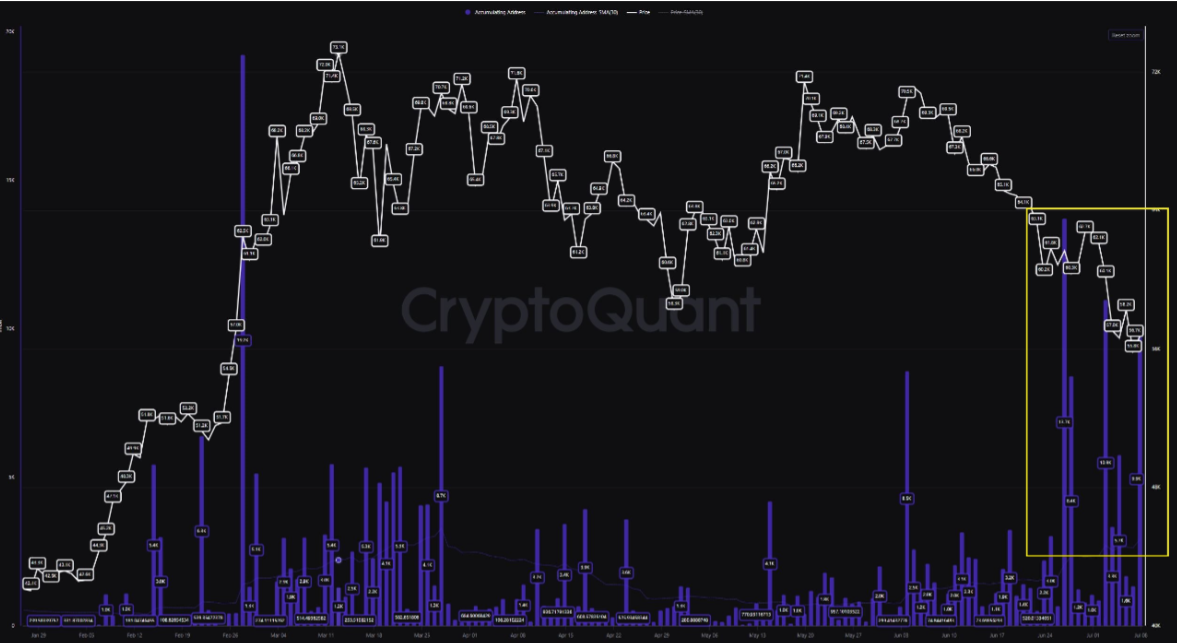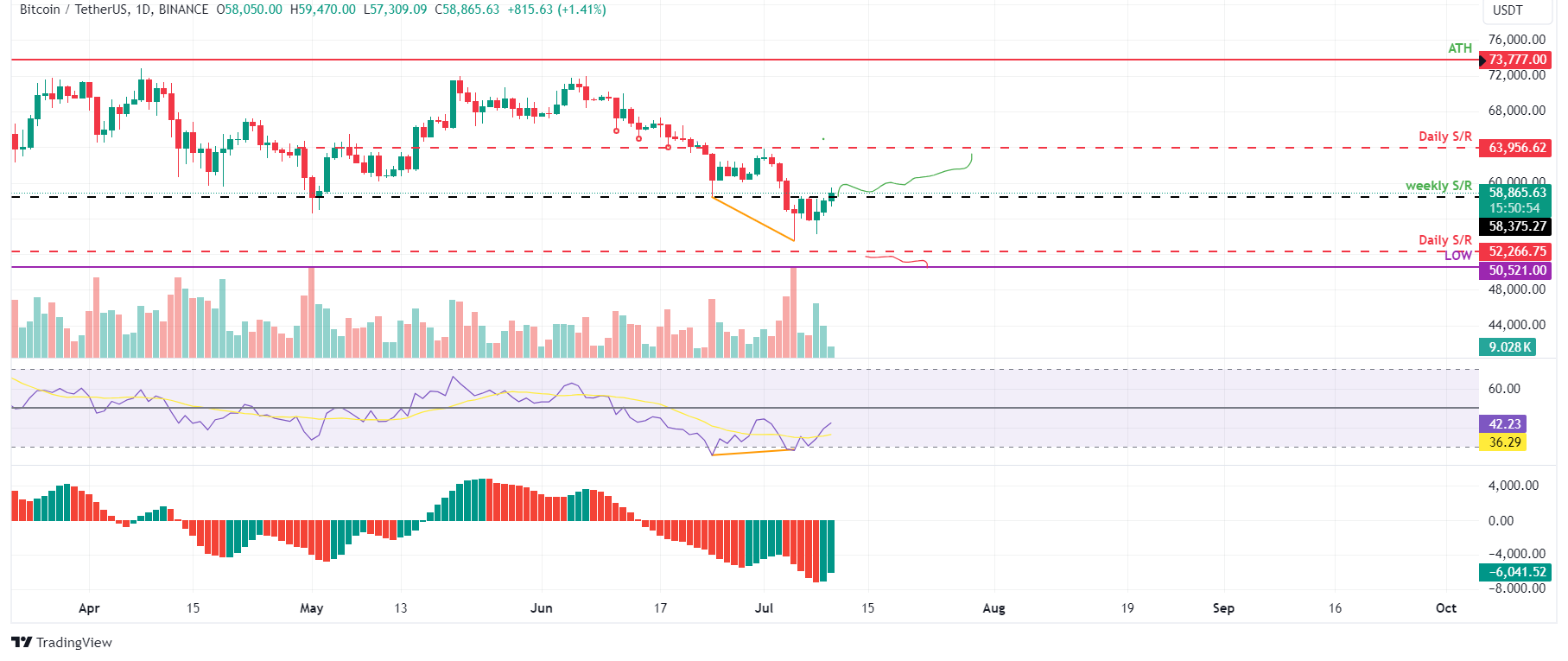- Bitcoin spot ETFs received the second consecutive day of inflows this week on Tuesday.
- On June 5 and 6, 35,486 BTC outflowed from BitMEX, marking the second-largest BTC outflow in the exchange.
- Despite FUD from Mt. Gox and the German government, on-chain data shows investors quietly accumulating BTC.
- Technical analysis shows that BTC has formed a bullish divergence on a momentum indicator.
Bitcoin (BTC) has encountered resistance near the $58,375 weekly level during the past few days, trying to break and hovering just above it at $58,865 at the time of writing on Wednesday. Concurrently, on-chain data reveals quiet BTC accumulation, alongside a notable outflow of 35,486 BTC from exchanges on June 5 and 6, marking BitMEX’s second-largest outflow in history. In addition, Bitcoin spot ETFs received $216.4 million in inflows on Tuesday, marking the second consecutive day of positive netflows this week. Technical analysis also indicates a bullish divergence on a momentum indicator, suggesting a potential rally ahead.
Daily digest market movers: Bitcoin has recorded the second-largest Bitcoin outflow in BitMEX history
- According to on-chain market intelligence and analytics platform CryptoQuant, Bitcoin Exchange Netflow data from BitMEX has recorded the second-largest Bitcoin outflow in history. Historically, the Exchange Netflow indicator on BitMEX has shown a strong inverse correlation with Bitcoin price movements.
- When this indicator turns highly negative, indicating significant BTC outflows from exchanges, Bitcoin’s price rises. Large BTC outflows from BitMEX suggest that major investors withdraw their holdings, possibly for cold storage or strategic sales on other platforms. This behavior reduces immediate selling pressure on the exchange, stabilizing or potentially increasing Bitcoin’s price.
- Recently, an outflow of 35,486 BTC occurred, marking the second-largest BTC outflow in BitMEX’s history.
Bitcoin Exchange Netflow (Total) – BitMex chart
- On Tuesday, US spot Bitcoin ETFs recorded their second consecutive day of inflows this week of $216.4 million. This surge indicates increasing investor confidence, suggesting a potential short-term uptick in Bitcoin’s price. Monitoring net inflow data from these ETFs is vital for assessing investor sentiment and comprehending market trends. Together, the 11 US spot Bitcoin ETFs presently hold reserves amounting to $49.14 billion in Bitcoin.
Bitcoin Spot ETF Net Inflow chart
- Additionally, data from CryptoQuant reveals that amid the FUD (Fear, Uncertainty, Doubt) triggered by Mt. Gox’s and the German government’s fund transfers on exchanges over the past weeks, certain investors are discreetly accumulating BTC, as shown in the chart below.
Bitcoin Accumulation chart
- Coinglass Bitcoin Long/Short Ratio provides insight into market sentiment among traders and investors regarding Bitcoin’s price direction. A high long/short ratio typically suggests bullish sentiment, indicating that more traders are betting on increasing Bitcoin’s price. Conversely, a low ratio may indicate bearish sentiment, suggesting more traders expect Bitcoin’s price to decrease.
- In BTC’s case, the long-to-short ratio was 1.081, meaning there are 1.081 times as many long positions as short positions, further bolstering BTC’s bullish outlook.
Bitcoin Long/Short Ratio chart
Technical analysis: BTC momentum indicators show bullish divergence
Bitcoin price has faced resistance near the weekly level of $58,375 over the last four days. BTC/USDT is testing that level and hovers just above $58,865, marking a 1.3% increase on Wednesday.
Additionally, the formation of a lower low in the daily chart on July 5 contrasts with the Relative Strength Index’s (RSI) higher high during the same period. This development is termed a bullish divergence and often leads to the reversal of the trend or a short-term rally.
If BTC’s daily candlestick closes above the $58,375 weekly resistance level, it could rise 9% to revisit the daily resistance at $63,956.
BTC/USDT daily chart
On the other hand, if BTC closes below the $52,266 daily support level and forms a lower low in the daily time frame, it could indicate that bearish sentiment persists. Such a development may trigger a 4% decline in Bitcoin’s price to revisit its daily low of $50,521 from February 23.
Cryptocurrency metrics FAQs
The developer or creator of each cryptocurrency decides on the total number of tokens that can be minted or issued. Only a certain number of these assets can be minted by mining, staking or other mechanisms. This is defined by the algorithm of the underlying blockchain technology. Since its inception, a total of 19,445,656 BTCs have been mined, which is the circulating supply of Bitcoin. On the other hand, circulating supply can also be decreased via actions such as burning tokens, or mistakenly sending assets to addresses of other incompatible blockchains.
Market capitalization is the result of multiplying the circulating supply of a certain asset by the asset’s current market value. For Bitcoin, the market capitalization at the beginning of August 2023 is above $570 billion, which is the result of the more than 19 million BTC in circulation multiplied by the Bitcoin price around $29,600.
Trading volume refers to the total number of tokens for a specific asset that has been transacted or exchanged between buyers and sellers within set trading hours, for example, 24 hours. It is used to gauge market sentiment, this metric combines all volumes on centralized exchanges and decentralized exchanges. Increasing trading volume often denotes the demand for a certain asset as more people are buying and selling the cryptocurrency.
Funding rates are a concept designed to encourage traders to take positions and ensure perpetual contract prices match spot markets. It defines a mechanism by exchanges to ensure that future prices and index prices periodic payments regularly converge. When the funding rate is positive, the price of the perpetual contract is higher than the mark price. This means traders who are bullish and have opened long positions pay traders who are in short positions. On the other hand, a negative funding rate means perpetual prices are below the mark price, and hence traders with short positions pay traders who have opened long positions.


%20-%20BitMEX-638562035442921959.png)







